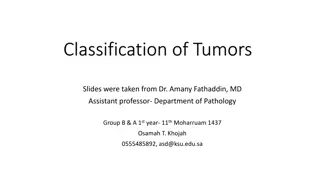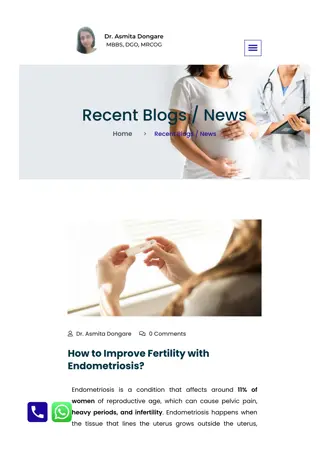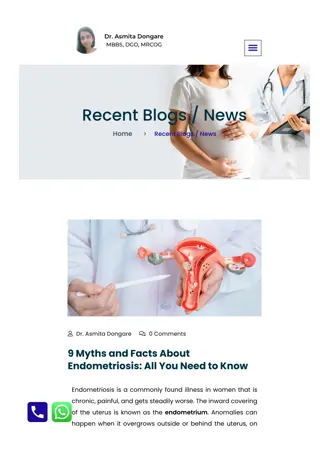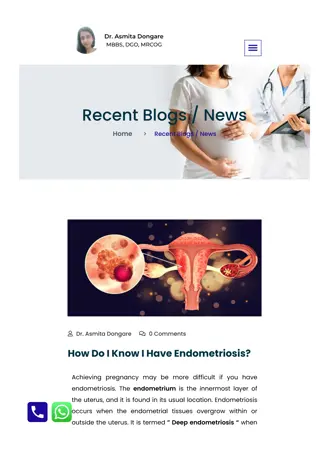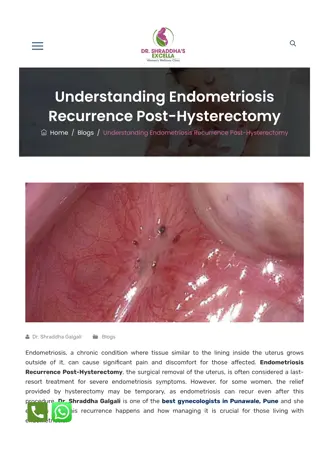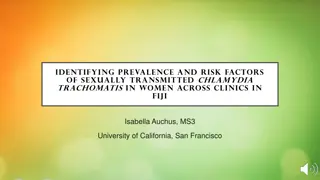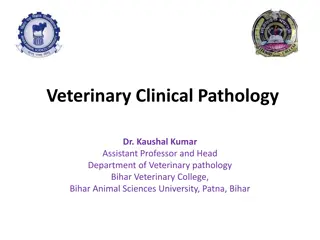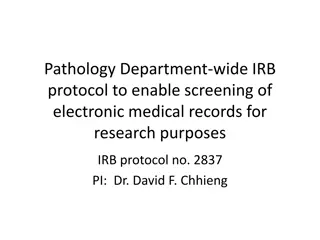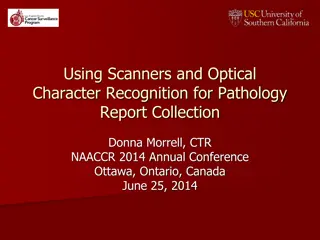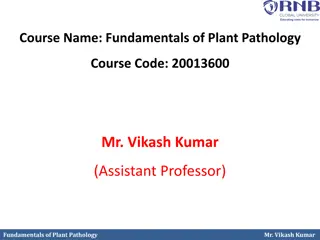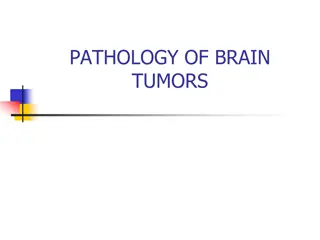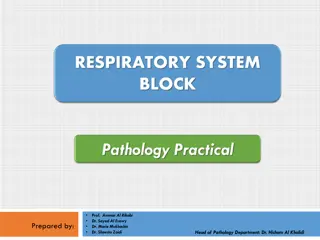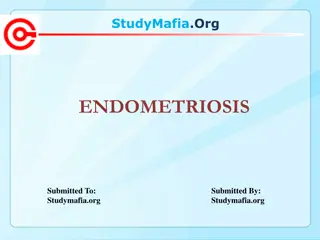Endometriosis: Definition, Prevalence, and Pathology
Endometriosis is the presence of endometrial tissue outside the uterus. Explore its definition, prevalence factors, sites affected, and pathology characteristics such as cyclic growth and shedding. Learn about the clinical features of pelvic endometriosis and the common manifestation in the ovaries and pelvic structures.
Download Presentation

Please find below an Image/Link to download the presentation.
The content on the website is provided AS IS for your information and personal use only. It may not be sold, licensed, or shared on other websites without obtaining consent from the author.If you encounter any issues during the download, it is possible that the publisher has removed the file from their server.
You are allowed to download the files provided on this website for personal or commercial use, subject to the condition that they are used lawfully. All files are the property of their respective owners.
The content on the website is provided AS IS for your information and personal use only. It may not be sold, licensed, or shared on other websites without obtaining consent from the author.
E N D
Presentation Transcript
ENDOMETRIOSIS Definition The presence of functioning endometrium (glands and stroma) in sites other than uterine mucosa is called endometriosis. It is not a neoplastic condition, these ectopic endometrial tissues may be found in the myometrium when it is called endometriosis interna oradenomyosis. Prevalence During the last couple of endometriosis has been increasing both in terms of real and apparent. The real one is due to delayed marriage, postponement of first conception and adoption of small family norm. The apparent one is due to increased use of diagnostic laparoscopy as well as hightened awareness of the disease the prevalence is about 10 per cent. However, prevalence is high amongest the infertile women (30-40%) as based on diagostic laparoscopy and laparotomy. decades, the pervalence of
Abdominal Abdominal It can occur at any site but is usually confined to the abdominal structures below the level of unbilicus. Common structures involved in order of frequency are ovary, pouch of douglas, uterosacral ligament, broad ligament, rectovaginal septum, rectum and pelvic lymph nodes. Rare sites aregutappendix, ureterand urinary bladder. Extra-abdominal The common sites are abdominal scar of hysterotomy, caesarean section, tubectomy and myomectomy, umbilicus, episiotomy scar, vagina and cervix. Extra-abdominal Remote
Coelomic metaplasia (Meyerand Ivanoff) Chronic irritation of the pelvic peritoneum by the menstrual blood may causecoelomic metaplasiawhich results in endometriosis.
Pathology General considerations 1. The endometrium (glands and stroma) in the ectopic sites has got the potentiality to undergo changeunder the action of ovarian hormones. 2. While proliferative changes are constantly evidenced, the secretory changesareconspicuously absent in many; 3. Cyclic growth and shedding continue till menopause. 4. As the blood is irritant, there is dense tissue reaction surrounding the lesion with fibrosis. 5. Fallopian remain patent. Pelvicendometriosis Typically,there are small black dots, the socalled powder burns seen on tyhe uterosacral ligaments and pouch of douglas. Fibrosis and scarring in the peritoneum surrounding the implants is also a typical finding. Othersubtle appearances are : red flameshaped areas, red polypoid areas, yellow brown patches,powders burn theovaries are frequently involved usually bilaterally. Theendometriomas (chocolate cysts ) are of varying sizes and arevisibleas bluish
Colouratious. The ovaries get adherent to the pelvic structures including rectum and sigmoid colon. CLINICAL FEATURES OF PELVIC ENDOMETRIOSIS Patient profile Symptoms About 25 per cent of patients with endometriosis have no symptom, beaing accidentally discovered eitherduring laparoscopy or laparotomy. Symptoms are not related with extentof lesion. Depth of penetration is more related to symptoms rather than the spread. Lesions penetrating more than 5 mm are responsible for pain, dysmenorrhoeaand dyspareunia. 4. Non-pigmented endometriotic lesions compared to classic pigmented powder burns lesions produce more prostaglandin F (PGF) and hence are more painful. The symptoms are mostly related to the site of lesion and its ability to respond to hormones. Midline lesionsare moresymptom 1. 2. 3. 5.
Dysmenorrhoea(50%) There is progressively increasing secondary dysmenorrhoea. The pain starts a few days prior to menstruation; gets worsened during menstruation and takes time, even after cessation of period, to get relief of pain, the site of pain is usuallydeep seated and on the back or rectum. Increased secration of PGF 2a, thromboxane B2 from endometriotic tissue is the causeof pain. Abnormal menstruation(60%) Menorrhagia is the predominant abnormality. If the ovaries are also involved, polymenorrhoea Infertility(40-60%) Whether endometriosis causes endometriosis is not clear. Endometriosis is found in 20-40 per cent of infertilewomen. Dyspareunia The dyspareunia is usually deep. It may be due to stretching of the structures of the pouch of douglas ordirectcontact tenderness. As such, it infertility or infertilityproduces
Is mostly found in endometriosis of the rectovaginal septum or pouch of douglas and with fixed retroverted uterus. Abdominal Pain There may be variable degrees of abdominal pain around the periods. Somethimes, the pain may be acute due to rupture of chocolate cyst. Chronic pelvic pain Other Symptoms Bladder frequency, dysuria or even haematuria Sigmoid colon and rectum painful defecation (dyschezia), diarrhoea, rectal bleeding or even melena. Abdominal examination A mass may be felt in the lower abdomen arising from the pelvis enlarged chocolate cyst or tubo-ovarian mass due to endometrioyic adhesions. The mass is tender with restricted mobility. 1. 2.
Pelvic examination Bimanual examination may not reveal any pathology. The expected positive findings are pelvic tenderness, nodules in the pouch of douglas, nodular feel of the uterosacral ligaments, fixed retroverted uterus or unilateral or bilateral adnexal mass of varying sizes. DIAGNOSIS Serum Marker CA 125 Imaging Ultrasonography 2. Computed tomography (CT) 3. Confirmation is by double puncture laparoscopy (gold standard) or by laparotomy. 4. Biopsyconfirmation 1. 1.
DIFFERENTIAL DIAGNOSIS Chronic pelvic infection 2. Ovarian endometrioma (chocolate cyst) 3. Benign ovarian tumour 4. Malignant ovarian COMPLICATIONS OF ENDOMETRIOSIS The following complications mayoccur: Endocrinopathy This may be mostly responsible for infertility. Ruptureof chocolate cyst. 3. Infection of chocolate cyst. 4. Obstructive features: - Intestinal obstrucation - hydronephrosis 5. Malignancy is rare, the commonest one being abenoacanthoma 1. 1. 2. hydroureter renal infection
Levonorgestrel-releasing-IUCD dysmenorrhoea, pelvic pain, dyspareunia and menorrhagia singnificantly useful forrectovaginal endometriosis. when used, is found to reduce
SURGICAL MANAGEMENT OF ENDOMETRIOSIS INDICATIONS Endometriosis with severe symptoms unresponsive to hormone therapy. 2. Severe and deeply infiltrating endometriosis to correct the distortion of pelvic anatomy. 3. Endometriomas of more than 1 cm. CONSERVATIVE SURGERY Conservatine surgery is planned to destroy theendometriotic lesions in an attempt to improve the symptoms (Pain, subfertility) and at the same time to preserve the reproductive function. Laparoscopy is commonly done todestroy endometriotic lesions by excision orablation byelectrodiatherapy. Laparoscopic uterosacral nerve ablation (LUNA) 1.


